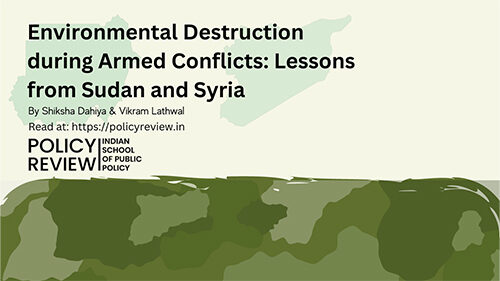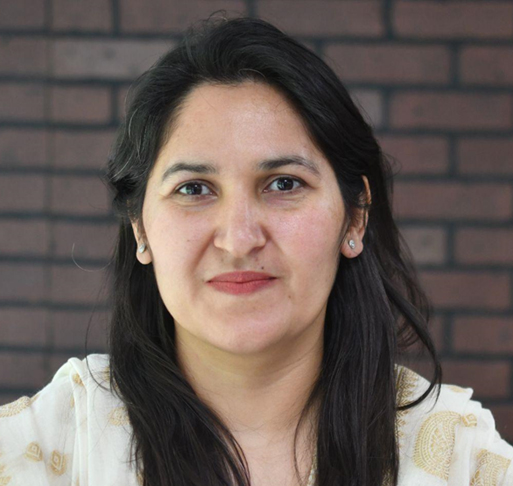
Environmental Destruction during Armed Conflicts: Lessons from Sudan

Armed conflicts can have significant and enduring effects on the environment. Their adverse effects can be severe and widespread, ranging from eradicated forests and other habitats to polluted soil and water. The disruption of environmental management systems and the inability to access natural resources can also have detrimental effects on the health of people and the environment. Therefore, it is essential to explore and comprehend the impact of ongoing armed conflicts on the environment and the regional ecosystems.
The first case is the African nation of Sudan. Sudan has abundant natural resources like oil, forests, and agricultural lands. However, a long protracted conflict in the country, coupled with the irresponsible use of natural resources, has led to several serious environmental problems like desertification, deforestation, biodiversity loss, water scarcity, tribal and ethnic warfare, and widespread poverty.
Restricted access to affected areas due to the ongoing hostilities has significantly hampered environment preservation in Sudan. The loss of civic infrastructure like water treatment facilities and sewage systems has spread diseases and contaminated water supplies, worsening the country’s humanitarian catastrophe. As a result, carrying out environmental impact studies and implementing effective management plans have proven difficult.
The use of explosives and other military equipment during the conflict has also led to air pollution. For instance, in Darfur, the use of heavy artillery and bombs has resulted in large amounts of dust and smoke, which can cause respiratory problems for people and wildlife. Additionally, the burning of wood and other materials for cooking and heating purposes can lead to indoor air pollution, which can also have negative health impacts.
A “deforestation disaster” affecting several vulnerable areas has resulted in the loss of about 12% of Sudan’s forest cover in just 15 years. In fact, within the next 10 to 15 years, some places might completely lose their forest cover. The most severe repercussions have been indirect: forced migration, weak governance, resource exploitation, and a lack of investment in sustainable development.
Furthermore, the conflict is fostered by rivalry over natural resources including oil and gas, the Nile’s waters and timber, as well as farmlands. In villages, diseases occur due to open water sources like ponds. Waterborne illnesses like diarrhoea, cholera, and hepatitis E in the Darfur region have been the primary cause of many deaths. Other diseases like Guinea worm disease, or dracunculiasis was also brought on by contaminated drinking water.
According to a report by the United Nations Environment Programme (UNEP), the conflict has displaced wildlife populations and destroyed their habitats, particularly in the Darfur region. The report notes that large numbers of wildlife, including elephants, giraffes, and other large mammals have been killed for their meat, or due to other conflict-related activities such as military operations.
Additionally, the conflict has displaced many communities from their traditional lands. This has led to increased pressure on wildlife habitats as people move into new areas to seek resources for survival. This can increase hunting and poaching of wildlife, as well as the destruction of habitat through activities such as charcoal production and agriculture.
Despite these difficulties, there have been some initiatives in Sudan to safeguard the environment. International organisations like the United Nations, have tried to support and aid local populations by restoring their civic infrastructure and providing them with clean water. Additionally, some regional groups have created neighbourhood-based environmental management programs such as campaigns to repair forest damage and advance the use of renewable energy sources.
Nevertheless, more work needs to be done to safeguard Sudan’s ecosystem and ensure the long-term sustainability of the impacted areas. In addition, the empowerment and involvement of local populations to assume roles as environmental stewards is also important. This will require continuous investment and assistance from the international community. In Sudan, it will be feasible to lay the groundwork for a more sustainable and peaceful future by tackling these issues and working to protect the environment.
The Syrian armed conflict is another such example that has caused immense environmental destruction in the region. The conflict has had a considerable negative impact on the environment with temporary oil refineries, demolished infrastructure, debris, a dysfunctional waste disposal system, and munition remnants being the main contributors. Munitions that contain hazardous materials like depleted uranium have contaminated the groundwater.
The extensive use of explosive weapons, including landmines and barrel bombs, has led to the loss of forests and other habitats. This has had a detrimental effect on the local biodiversity and the life of local communities that depend on these resources. Additionally, human and ecological health have suffered due to the pollution of the soil by hazardous substances like oil spills and the release of toxic chemicals.
The massive population displacement brought on by the conflict has also harmed Syria’s natural ecosystems. Natural resources have come under immense pressure as a result of the involuntary dependency on these resources by millions of Syrians for their survival. Resources like water and wood have been used excessively, which have depleted natural ecosystems and reduced biodiversity.
The conflict has increased wildlife poaching and trafficking, as people have turned to these activities for economic survival. For instance, in 2019, Turkish law enforcement seized around 2,000 goldfinches that were smuggled from Syria. Lebanon has become a market for these smuggled birds from Syria. Furthermore, various rare and protected species, including chameleons, are being frequently targeted by traffickers. Jordan has become a transit route for these smuggled species to reach markets in the Gulf.
The displacement of people in Idlib and parts of Aleppo has resulted in illegal logging and deforestation. Trees have been cleared to create space for makeshift camps to accommodate millions of Internally Displaced People (IDPs) who have fled to the northwest provinces. In order to heat themselves, IDPs have cut down trees, especially during the winter months when fuel prices rise and the region is subjected to extremely cold temperatures. Unfortunately, this has also led to tragic consequences as a family was asphyxiated in its tent after attempting to use coals to keep warm during the winter.
It is clear that the conflict in Syria has had a significant and widespread impact on the natural environment of the nation. Dealing with these effects will be a significant task in the process of recovery and rebuilding. Investing in research and data collection activities will be critical to comprehending the full extent of the conflict’s effects on the environment and establishing targeted plans to protect and restore natural resources. Involving and empowering local communities will be essential for developing effective environmental management systems that can be sustained despite ongoing conflicts.
The fact that the environment is frequently viewed as a secondary issue compared to more pressing human needs and security concerns is one of the main obstacles to conserving the environment during armed conflicts. Even when it is obvious that conflicts have a large negative influence on the environment, there is a lack of attention and a reduction in resources committed to environmental protection. Additionally, it might be challenging to put into action efficient environmental management measures and enforce environmental laws and regulations due to the turmoil and instability brought on by these conflicts.
Despite these obstacles, there are a few things that can be done to safeguard the environment in times of armed conflict. Ensuring that environmental factors are taken into account during the planning and decision-making stages of military and humanitarian operations is a crucial strategy. This may involve including environmental evaluations in the planning of military operations and ensuring that their possible environmental effects are thoroughly considered. Environmental protection objectives can be incorporated into peace agreements. Other initiatives to rebuild and recover after violence can involve working with neighbourhood communities and organisations to identify and address environmental concerns.
Register your Interest to Study at ISPP
Encouraging environmentally friendly technologies and methods can protect the environment during armed hostilities. This could involve encouraging the use of eco-friendly logistics and transportation systems, promoting the purchase and use of eco-friendly products, and assisting with the development of renewable energy sources. By employing these strategies, military and humanitarian organisations can decrease their environmental impacts and contribute to the long-term sustainability of the affected areas.
Ensuring the long-term sustainability and well-being of communities affected by armed conflicts is complex and challenging. But, it is also crucial. Implementing strategies like integrating environmental considerations into military and humanitarian operations, promoting the use of environmentally friendly technologies and practices, and enhancing local communities’ ability to manage and protect their natural resources can go a long way in addressing the challenges. It can help reduce the detrimental effects of armed conflicts on the environment and lay the foundation for a more sustainable and peaceful future.

Shiksha Dahiya
Shiksha Dahiya is a public policy scholar at the Indian School of Public Policy. She is the Co-founder of Pukaar Foundation (NGO). Shiksha has previously worked in legal academia in Delhi NCR, including at the Faculty of Law, Delhi University. She is interested in research and advocacy of environmental and technology policies.

Vikram Lathwal
Vikram Lathwal is an Assistant Professor of Law at SGT University and a PhD scholar at Panjab University, Chandigarh. He is currently researching on Environmental Impact Assessment as a tool to achieve procedural environmental justice, particularly focusing on the state of Haryana.

